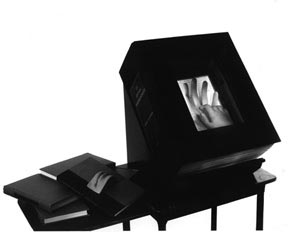
The Surprising Spiral
1991
collection of Zentrum für Kunst und Medientechnologie (Center for Art and Media | ZKM), Karlsruhe
The Surprising Spiral is an interactive artwork, utilizing a computer controlled videodisc, computer graphics, digitized sounds and texts, and synthesized voices, embedded within sculptures. The work responds to the form of the viewer/participant's engagement. The viewer's ability to interact and direct the flow of images and sounds allows him or her to "play" the piece, to seek or escape from finding a destination, or to enjoy its labyrinthine paths.
There are two sculpture/interface objects through which a viewer can interact with the work. One is a large, hollowed out, handmade book (13" × 15" × 6") in which are encased replicas of human hands. In a cut out in the center of the cover is embedded a transparent touch screen, which appears to be the glass "cover" of the book. On this touch screen are fingerprints, placed above the fingertips of the larger hand within the book. When a viewer touches any of the fingerprints, various things can happen: there are always sound responses to these touches, usually speech; the video can change to another location in the world, or an animated text might be evoked. In any case, a turn is taken in the labyrinth.
The work has a complex cause and effect structure, and a touch that the viewer makes might have an immediate visual response, happen a short time later, or much later. I wanted these to mirror our daily cause and effect experiences. That is, sometimes we see the results of an action immediately, very soon, much later, etc. No two viewers will see the same flow of images or hear the same sounds in the same sequence, and the actions of previous viewers will also affect the structure found by another viewer.
On the spine of the book is the title La Espiral Sorprendente, the title of the work in Spanish. It is an homage to Borges and Paz, the writers who inspired this work. The other interactive object is also a book, an actual book of Octavio Paz, The Monkey Grammarian. Embedded in the cover of the book is a casting of a man's lips, and between the lips a faint red light glows. When a viewer holds their fingertips upon the lips, one hears texts from the book spoken aloud. When the hand is removed, the text ceases, the mouth falls silent again.
If no one does anything to interact with the work for a length of time, it follows a path of images which lead to one of the looped "nature" images. At this point, the work will also clear its memory of the touches previous viewers have made, and it begins anew when touched again. These objects are set upon furniture sculptures which I made, and these stand upon a painted wooden platform.
The work is about the simultaneous sensations of ecstasy and emptiness which arise from the labyrinthine nature of traveling, of being in motion; the mind reflecting upon itself and upon the organization of languages, thoughts and perceptions. Images flow from one place in the world to another, a continuous movement of the passenger, the one walking through, passing through; the view of the world along the path, with no end in mind. These are images which I recorded from 1979 to 1991, in the USA, India, Japan, Argentina, Thailand, Scotland, Sri Lanka, utterly without any conception of cinematic mise en scène.
They are the remains, the visual and auditory residuum of what has been passed by, moved through. As a
reverse side, moments of the camera's fixity which have observed what we think of as "nature", that is,
time outside of our own determinations, events unfolding oblivious to human purposes, the temporal order
which marks our own passage through time, whether we are in motion or not.
kf, 1991
online references:
The Surprising Spiral : Where Sand and Logic Don't Meet by Regina Cornwell
The History of the Interface in Interactive Art by Söke Dinkla
Seeking Deeper Contact (Interactive Art as Metacommentary) by Erkki Huhtamo
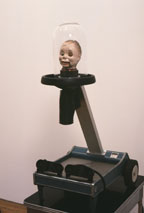
Jimmy Charlie Jimmy
1992
The head of a tattered ventriloquist–doll with glazed–over eyes is set under a glass dome, sitting atop a small instrumentation cart with wheels, as if mobile, but unmoving – except for its constant speaking. Its pathetic mouth flapping away, Jimmy Charlie Jimmy is on a constant monologue, until someone approaches him closely. Then, he stops speaking, and if the viewer should happen to talk to him, their words, in their own voice, are repeated by the doll, over and over, until the visitor steps away.
Jimmy Charlie Jimmy has had a number of different personality monologues since first made in 1992. The most recent version speaks the text of Samuel Becket's work The Lost Ones.
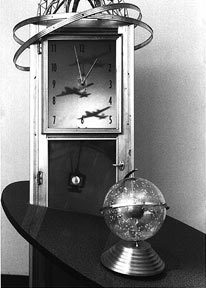
Childhood / Hot & Cold Wars (The Appearance of Nature)
1992–93
At the center of my work Childhood / Hot & Cold Wars (The Appearance of Nature) I have undertaken a search for my childhood TV memories, a kind of archeology of those images and sounds which I remember, or see now, as having been formative in my personal understanding of what was "going on" in the world.
I grew up watching television. Some of my earliest and most vivid sensory and emotional memories are of television programs I saw in my first years. The themes of my childhood emerged amid ever–present references to World War III, the atom bomb, the Communist Threat and the Domino Theory, intersected by the emergence of suburbia, Sputnik, the Space Race and promises of endless progress in a fantastic technological future in which I would be visiting other worlds.
These recurring themes were played out through TV characters, news, advertisements, science fiction films, children's programs, and Civil Defense films – a strange mixture of cartoon violence, sci–fi monsters, cowboys and Indians, and "air raid drills". In school and at home, we practiced for nuclear attack, and watched people, monsters, and cartoon animals killing each other on TV. It seemed natural, the way things were. I was learning, in a way, to learn violence as the language of the world, as a kind of entertainment.
The work is a complex, hybrid object; it has aspects of a "grandfather clock", intersected by a Formica dining table, parts of a suburban tract house, and the roof is a replica of the Hiroshima building called the A–bomb Dome, a surviving skeleton which now stands as a memorial. The object is made primarily of aluminum, approximately 7 feet high.
The face of the clock has numbers and hands as an ordinary clock, but this face is also a screen upon which the video images are rear–projected from within the body of the clock. The front of the clock body is a typical 50s "screen door" (also referring to the TV/cinema screen, and "screen memories" – so important to this work), made from the actual door of my parents' home. Intersecting the body of the clock is a skewed dining table. On it sits a globe – a transparent celestial globe mapping the heavens, with a smaller earth globe within it. Behind the globe, below the clock–face, is a window through which a small tele–pendulum marks seconds with each swing.
Standing alone, the work plays these TV fragments as if "ticking" on the clock face. Playing like a step–frame animation, at one field per second, one sees sequences of still images. It takes 24 hours to play its full cycle of images and sounds in this manner.
The work has interactive aspects. It has been organized in such a way that a viewer who becomes physically involved with the work – by turning the globe – affects the ways in which the TV images and sounds are played, and may move through them forward and back in time.
The circuits and software I have made respond to gestures and types of movements,
rather than simply following the participant's spinning as a "trackball" might.
Like fragments of early memories, disconnected, crystal–clear, momentary – the
"seconds, minutes, and hours" in this work are stretched to infinity, going around
over and over (as in my mind) with the hands of the clock, changing through the
interaction of a viewer–participant, or going along without them. Forgetting,
returning, forgetting, returning...
kf 1993
online references:
Resurrecting the Technological Past by Erkki Huhtamo
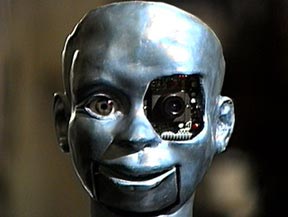
where I can see my house from here so we are
1993–94
→ early VRML model (made by construct.net in 1995)
A virtual masquerade party, a MOO with mirrors, a remote–control puppet–theater, a world of "waldos", one of the unbearable hells, or the beginning of a new form of public space... these spin off at the thought of this work, one which was conceived as live video became possible on the Internet several years ago.
The inconceivable space between "here" and "there" collapses in an audiovisual materialization of the connection, and those who meet in that place "lose" their body along the way, inhabiting another when they arrive.
Three small robot–puppets, each with a video camera–eye, and microphone ears, are together in a mirrored space. In this version of the work, the mirrored space is in an exhibition site; its walls are high enough so that the robot–puppets can't see directly over them, but low enough so that viewers to the exhibition may watch them, and speak with them. Another version has the mirror–space in a closed room – which one could only enter through "cyberspace".
Each robot–puppet is connected, via the Internet, to another space, elsewhere, in which their sight and hearing is seen and heard by a distant viewer–ventriloquist as projected video and amplified sound. In each remote space, there is a control device, consisting visibly of an opened attaché–case–like object, revealing a joystick and a microphone.
Utilizing the resources and tools of the Internet's Mbone (a virtual layer on the Internet which provides real–time flow of audio and video, made possible by the work of Steve Casner, Steve Deering, Ron Frederick, Van Jacobson, Steve McCanne, and others), and remote–control software I have put together, the viewer–ventriloquist may drive around the robot–puppet to which they are connected in the mirrored space, and when the remote viewer–ventriloquist speaks, their voice is "projected" through the robot–puppet, amplified within it, and moves the robot–puppet's mouth.
In this way, three viewer–ventriloquists may meet in the fourth (mirrored) room, and exchange with each other as they please, or participate in directed theatrical performances. The space has physical limits for each robot–puppet, like national borders which they cannot cross, and their wires are only so long... vain tropes, perhaps, but reminders...
Maybe... creating a "videoconference" among three ventriloquist puppets would
be enough to ask the guest ventriloquists – "What is there to say? Does it make
a difference that you are not seen, but only your projection – which sees and
speaks and hears in your place? Is it the 'I' saying 'Me' to 'It–You' (or its
reflection)? That the one who stands in your place is not free to go where they
wish, and that even as you move them 'freely' in their mirrored infinity
theater, that there are borders? That they can see their wires but know not
where they lead? And that in the space of the 'art exhibition' there is also a
meeting of those who see but are not seen and those who learn to play the game
with their projections?"
kf 1994
online references:
Seeking Deeper Contact (Interactive Art as Metacommentary) by Erkki Huhtamo
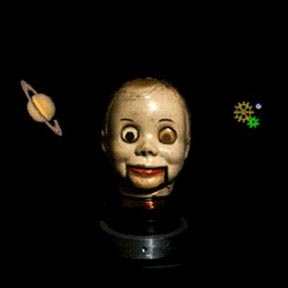
JCJ–Junkman
1995
CD–ROM project for artintact3, published by the
ZKM, Karlsruhe, 1996, and was shown in
"Can You Digit?"
at Postmasters Gallery, New York, March–April 1996,
and "Devices of Wonder"
at the J. Paul Getty Museum, Los Angeles, and "
Contaminados
" at the Museo de Arte y Diseño Contemporáneo, San Jose, Costa Rica, April–May 2002 (among many other shows).
The central figure on the screen is an image of the ventriloquist puppet–head I used in an earlier work, Jimmy Charlie Jimmy (1992), a worn–out relic with a glazed eye and peeling skin.
The initial screen reveals this head floating against black, surrounded by a whirling storm of ever–changing, appearing and disappearing "buttons" of many varieties. If one manages to "click" on one of the buttons, a piece of concrete sound is heard, and the puppet–head begins to speak, moving his mouth and repeating phrases. Sometimes a click will silence him. There is no beginning and no end, no other levels, no score. It is "interactivity" reduced to a zero–degree, as thousands of narrative fragments displace each other, fueled by a raw desire to get something.
All of the "buttons" and sounds in the work were made from files found on the
Internet – debris, more or less. The choices presented are made significant only
by one's ability, or inability, to catch them. The emotion produced is that any
choice will do, and so the work becomes a very peculiar game. Through this coming
together of clicking mania and network debris, one finds his speech patterns
evoking something like a personality, but since there is no fixed voice, it is
something of a meta–personality, a cutup. Its program is driven by approximations
of randomness and data cast adrift by others.
kf 1995
online references:
The Digital Revolution is a Revolution of Random Access by Grahame Weinbren
WINSIDE OUT: An Introduction to the Convergence of Computers, Games, and Art by Antoinette LaFarge
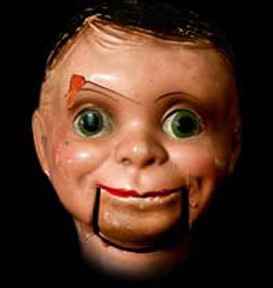
Orpheus
1996
Orpheus appears as the projected image of a speaking puppet head. The work is derived from the film Orphée (1950) by Jean Cocteau, and is intended for installation in a place removed from ordinary traffic – in a cave, an abandoned tower, or another obscure location.
From time to time, he speaks a declarative statement, and these are seemingly never repeated. The statements came about as follows: First, I used the original (translated) sentences from Cocteau's film – all of the phrases that were spoken over the radio, in sequence – as a grammatical matrix. So the matrix is a kind of cross–section of the original screenplay, paying attention to only one aspect of the film – the radio trick that Death arranges in order to lure Orpheus into the underworld, the "found texts" from the media that hypnotize Orpheus.
Then, I added further words (of my own), as possible words in the matrix. The computer program randomly pulls words from this matrix each time through the loop of the overall piece. In this way, the original syntax is fixed, but the poetry is "realtime" and variable.
shown at ACE Gallery, Los Angeles
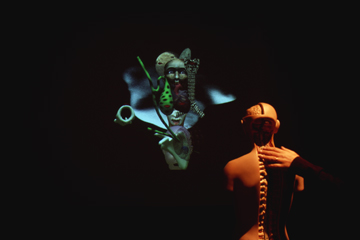
Interior
1997
Exhibited in the ICC Biennale '97, InterCommunication Center, Tokyo October–December 1997; ZKM | Center for Art and Media Karlsruhe October–December 1998; National Museum of Contemporary Art, Seoul (December 1998–January 1999); Postmasters Gallery, New York (February–March 1999); and " Unter Der Haut (Under the Skin)" at the Wilhelm Lehmbruck Museum, Duisburg, May–June 2001.
"Interior" is a room with a human medical torso standing in front of a large projection. Along the spine, small sensors (sensitive to close proximity as well as touch) are embedded. In the projection, talking organs of the body, masks, and puppet heads – all of whose speeches are all taken from transmissions received on radio scanners and recorded encounters on the street – enact a delirious masked theater within a shifting virtual landscape, changed by the way that the torso is touched.
Stroking the nervous system stirs up the cast of characters while scenes may be entered by keeping one's hands in the same place for some time. Some scenes can only be found if more than one person is touching simultaneously. "Interior" collapses time to repeated moments, repeating memories, unexplainable apparitions. Its hallucinatory scenes construct a kind of "mental space" in which these fragmentary representations of the body somehow become free and enact a cyclic, episodic drama. It is a delirious theater made of appearing and disappearing figures and voices, heterotopias of interiority, symbolic formations of the inexpressible.
"Feingold has built another universe of forms, where once again the body, the
surrogate body of a medical doll, allows one to configure the order of events. A
hallucinary narrative that is both inside and outside the body, where body parts
become ventriloquist dolls in a cyberspace that veers over the rooftops and the
sky, or is blinded by the harsh raster of video snow. Here are the avatars of
our newly disembodied existence, surreal, absurd, computerized, and even
threatening. A place of ambiguous fascination – seeing ourselves reflected
through this magic window that opens onto an abyss of charmed monstrosities that
are all our progeny."
– from the catalog of the ICC Biennale '97
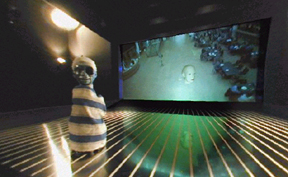
Séance Box No.1
1999
Exhibited in the
net_condition
exhibition, Sept 1999 – Feb 2000
an IPIX image of the installation
As if it might be a mediumistic being, this networked telepuppet performs on its stage at the whim of the one who moves it from a distance, and only this puppet master may speak with the ones from somewhere else. The visitors are seen by this puppet–medium, who learns to be the lens for the desires of the audience as they try to communicate with the ever–listening artificial actor. This agent provocateur floats in the image landscape before them, a speaking fountain given to rhyme, alliteration, and seemingly prophetic speech.
In this work–in–progress presentation of what will eventually be the setting for two parts of a 3–site performance, the boundaries crossed by voices are the keys to finding messages in the network medium.
Credits
Title: "Séance Box No.1 – work in progress"
Artist: Ken Feingold
Software Architecture and Direction: Ken Feingold
Software Development Assistance:
Visual programming and speech synthesis: Gideon May
Speech Recognition: Adolf Mathias
ForceFeedback Joystick Server: Andreas Schiffler, Timo Fleisch
AI development: Ken Feingold, Boriana Koleva, some original functions based on code by Duane Fields
Embedded applications: Ken Feingold
Software testing and content implementation: Ken Feingold
Hardware developers: Ken Feingold, Joachim Hund, H. Carl Ott, Armin Steinke
Production Managers: Sally Jane Norman, Heike Staff
Some technologies developed in collaboration with ZKM Karlsruhe and
i3net/eRENA (European Network for Intelligent Information Interfaces)
Date: 1993 – present (i3net/zkm project 1998–1999)
Status: work–in–progress, multi–location networked architecture for performance of
"Séance" (Ken Feingold, 1999)
Medium: mixed sculptural media, electronics, computer network, digital multimedia
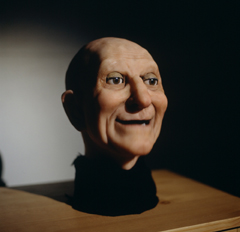
Head
1999
collection of
Kiasma Museum of Contemporary Art, Helsinki
photo: Pirje Mykkanen, The Central Art Archives, Finland
A very realistic animatronic human head sits on a small table, looking into space and blinking its eyes as if it might just be conscious. The visitor may hear it say something and be surprised enough to say something back to the head. Or perhaps the visitor already has heard about this thing, and comes in ready to talk. For what is most remarkable about this head is that it is able to understand spoken English, and it is able to engage in something like conversations. It listens to what is said to it, makes some ‘sense’ of it, and responds.
A descendant of early pseudo AI analyst programs like Eliza, personality disorder simulations like Parry, and the many severed speaking heads in science fiction films, this head has a very distinct and complex personality, with a predisposition to rhyming, alliteration, and prediction. Given certain verbal suggestions, it might begin uttering poetry, pronouncements, or get in a mood to be self reflexive.
Visitor: Hi
Head: Hello
V: How are you?
H: I am so offended. I can't tell if everyone would prod her to the left or not.
V: Who offended you?
H: The delicious conditions delay disturbed daredevils.
V: Which daredevils are disturbed?
H: The bothersome one
V: Which one is bothersome?
H: The absurd one
V: Who is absurd?
H: The unconscious
V: What is the unconscious?
H: It is something that makes me feel slow with groups.
V: That's interesting – why slow?
H: Because the kids wrinkled it. laaaaalaadeee moooommmm
V: Kids?
H: The child will tail the things which shrink.
V: Please explain
H: Didn’t you say something about presence?
V: No. Are you feeling argumentative?
H: I don't have any feelings. Would you like me to be more like something else?
V: Like what?
H: The robot will case octopi. Catch my drift?
V: What is your drift?
H: Where is my home? Anxious in the picture?
V: How would I know?
H: The hairy shipwrecks hang harmful mechanics. Would wood hood wood should should
should should would. Ixnxilaltylotl.
V: You make strange rhymes.
H: I am so exhausted. I wish someone would turn me off now.
online references:
An Encounter with the Computational Unconscious: Questioning Automatic Drama by Riikka Pelo
Abstraction Mechanisms in Computer Art by Cumhur Erkut